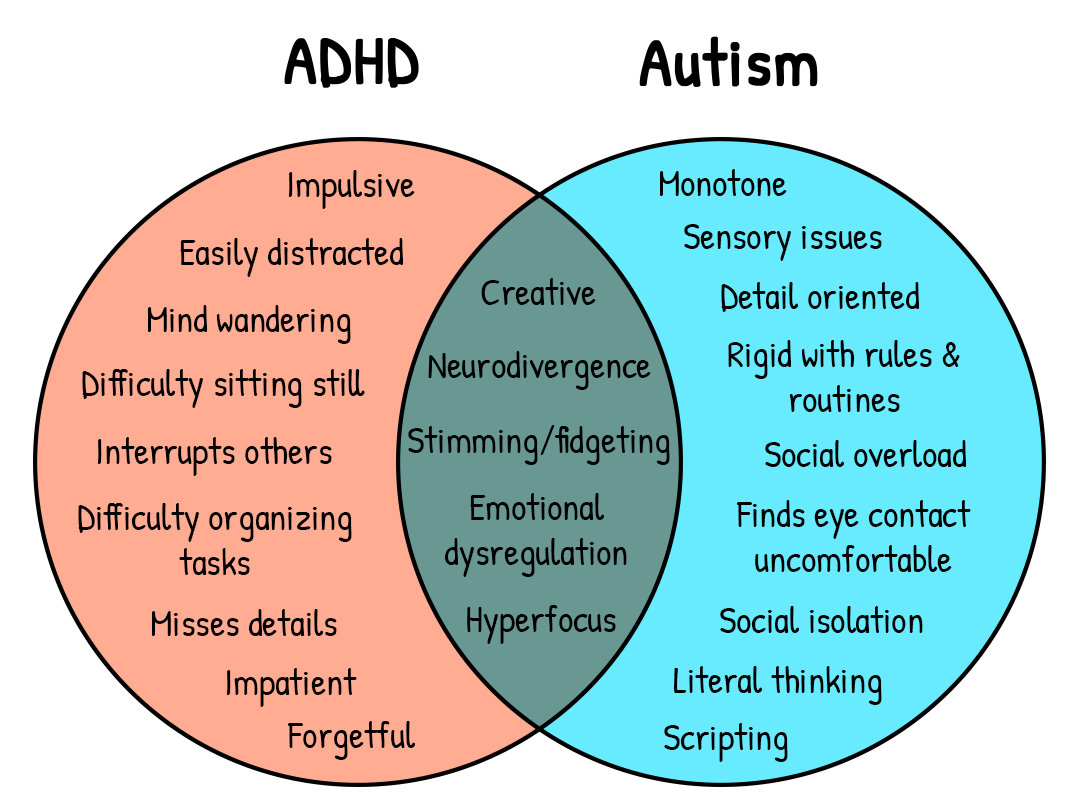How Can You Differentiate Between ADHD and Autism?

Strong 8k brings an ultra-HD IPTV experience to your living room and your pocket.
Understanding the difference between ADHD and Autism is essential for accurate diagnosis and treatment. While both are neurodevelopmental disorders that often share similar symptoms, they are distinct conditions with different causes, diagnostic criteria, and management strategies. This article will help you recognize the key differences and similarities to better understand ADHD and Autism.
✍️ Living with ADHD can be frustrating, but it’s also manageable. Visit our ADHD resource to learn how therapy, medication, and structured routines can change daily life for the better.
Understanding ADHD and Autism
What is ADHD?
Attention-Deficit/Hyperactivity Disorder (ADHD) is a brain-based condition that affects focus, impulse control, and activity levels. Individuals with ADHD often struggle with paying attention, staying organized, and controlling their energy.
What is Autism Spectrum Disorder (ASD)?
Autism, also known as Autism Spectrum Disorder (ASD), is a developmental condition that affects communication, behavior, and social interaction. People with autism may display repetitive behaviors, have specific interests, and face challenges in social situations.
Key Differences Between ADHD and Autism
Social Communication
Children with Autism typically struggle with understanding social cues, maintaining eye contact, or forming relationships. In contrast, those with ADHD may want to interact socially but lack the impulse control to do so appropriately.
Attention and Focus
People with ADHD tend to shift their attention quickly, becoming easily distracted by their surroundings. Individuals with Autism may hyper-focus on specific interests or activities, especially in areas they are passionate about.
Behavioral Patterns
Repetitive behaviors are a hallmark of Autism, such as hand-flapping, lining up toys, or needing strict routines. These behaviors are not typically seen in ADHD. On the other hand, impulsivity and hyperactivity are core features of ADHD, which may lead to disruptive actions.
Sensory Sensitivities
Children with Autism often have heightened or diminished sensory sensitivities to light, sound, touch, or smell. While people with ADHD can be distracted by stimuli, they usually do not have the same intense sensory responses as those with Autism.
Similarities Between ADHD and Autism
Overlapping Symptoms
There is a significant overlap in symptoms between ADHD and Autism, including difficulties with attention, executive function, emotional regulation, and social challenges. This can make diagnosis complex without professional evaluation.
Co-Occurrence of ADHD and Autism
It is possible for a person to be diagnosed with both ADHD and Autism. According to the CDC, about 30-50% of individuals with Autism also meet the criteria for ADHD. Recognizing this overlap is critical to developing an effective treatment plan.
Diagnosis and Treatment Approaches
How ADHD is Diagnosed and Treated
ADHD is typically diagnosed through behavioral evaluations, often including input from teachers, parents, and healthcare providers. Treatment usually includes behavioral therapy, educational support, and medication like stimulants.
How Autism is Diagnosed and Treated
Autism diagnosis involves observing a child's developmental history and behaviors using tools like the ADOS (Autism Diagnostic Observation Schedule). Treatment may include speech therapy, occupational therapy, and behavioral interventions like ABA therapy (Applied Behavior Analysis).
Importance of Early Intervention
Whether it’s ADHD or Autism, early diagnosis can significantly improve long-term outcomes. Interventions that begin in childhood can help individuals develop critical social, academic, and emotional skills that improve quality of life.
Living with ADHD and Autism
Challenges in School and Work
Both conditions can make school or work environments difficult. Children with ADHD may struggle with deadlines and classroom behavior, while children with Autism may face challenges with communication and sensory overload.
Support Systems and Therapies
Support from parents, teachers, and therapists plays a key role in managing ADHD and Autism. Customized IEPs (Individualized Education Plans) in schools can help address specific needs. Social skills groups, executive functioning coaching, and family counseling are also beneficial.
Navigating Daily Life
Routine and structure can greatly benefit individuals with either condition. For ADHD, setting reminders and breaking tasks into steps helps improve focus. For Autism, consistent schedules and visual cues reduce anxiety and improve comprehension.
Conclusion
Why Accurate Diagnosis Matters
Differentiating between ADHD and Autism is essential for ensuring individuals receive the most appropriate treatment and support. While these conditions can appear similar, the core differences require unique approaches. If you suspect a child or adult may be experiencing symptoms of either or both conditions, consulting a healthcare professional is the first step toward clarity and care.
Note: IndiBlogHub features both user-submitted and editorial content. We do not verify third-party contributions. Read our Disclaimer and Privacy Policyfor details.







